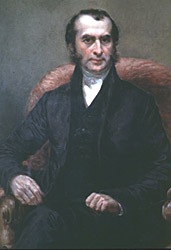Thomas Hodgkin: 1798-1866
“On some Morbid Appearances of the Absorbent Glands and Spleen” immortalized the name Hodgkin. He described a pathologic relationship between the lymph nodes and the spleen in his 1832 publication.
To many physicians, Thomas Hodgkin is mostly, if not only, known because of the malignant lymphoid disorder that carries his name.
However, Hodgkin made several contributions to society during his life. Some of these cost him his medical career at the age of 39, for it has been suggested that his vocal criticism of certain business practices of the fur trading Hudson Bay Company, his custom to drive in London side by side with black men and his refusal to accept membership of the Royal College of Physicians directly contributed to the fact that in 1837, after the position had become vacant, Hodgkin was not appointed as Assistant Staff Member at Guy’s Hospital.
The fact that Benjamin Harrison Jr., one of the directors of Hudson Bay Company and treasurer of Guy’s Hospital, was in charge of all appointments at Guy’s Hospital likely did not play in his favor.
The day after the hospital appointed Dr. Benjamin Babington, Hodgkin resigned and for all intents and purposes abandoned medicine. Five years later, he briefly returned to the field as a lecturer on the theory and practice of medicine and curator of the Museum of Morbid Anatomy at St. Thomas’ Hospital. But his comeback in pathology lasted just 10 months.
Pentonville, England
|
Source: Gordon Museum, King’s College London |
Hodgkin was born in Pentonville, England, on August 17, 1798. At the age of 21, he went to Guy’s Hospital and Medical School as a physician’s pupil.
Subsequently, he entered the Medical School in Edinburgh, Scotland, to study medicine – as a Quaker he was banned from Oxford and Cambridge.
In 1823, Hodgkin received his medical degree from Edinburgh University on a thesis entitled “De Absorbendi Functione.” In this work he described the functional relationship between lymph nodes and the spleen.
Nine years later he described a pathologic relationship between lymph nodes and the spleen. It is this 1832 publication, “On some Morbid Appearances of the Absorbent Glands and Spleen,” that immortalized his name.
Noteworthy is the fact that in this manuscript Hodgkin only reports on macroscopic changes found at autopsy; he never subjected the tissues to microscopic (histologic) analyses. Subsequent histopathologic examination has revealed that three, possibly four, of the seven patients described by Hodgkin actually had Hodgkin lymphoma.
Hodgkin acknowledged that he was not the first to describe this new disease entity; it most likely was Marcello Malpighi in 1666.
In fact, Hodgkin’s manuscript was barely recognized during his life and not even mentioned in his obituary. The eponym “Hodgkin disease” has been attributed to Dr. Samuel Wilks, who in 1865 published his third manuscript on this new condition, crediting and honoring Hodgkin by referring to this new disease in the title of the manuscript as “Hodgkin disease.”
Social justice
Hodgkin’s contributions to education and social justice are extensive and varied. During his tenure as lecturer and curator of the Museum at Guy’s Hospital, for example, Hodgkin suggested radical changes to medical education and training, including a greater emphasis on preclinical training and more attention to practical training (ie, walking the wards with a physician).
Hodgkin was also involved in public health issues. In 1832, social tension deepened in Great Britain after the country was struck by cholera. In two separate writings, one to the public, the other to the Board of Health, Hodgkin connected the deprived living conditions of the poor and cholera. He not only made specific hygienic recommendations but also urged the authorities to observe and record all available data to better understand it. Eventually many of his pamphlets, lectures and papers would be focused on the medical needs of the underprivileged, including public health care, housing and sanitation.
Time and again, Hodgkin maintained that the fundamental challenges of the poor were not medical but socioeconomic in origin. He also suggested that the working class be viewed and treated as a valuable national resource, something that still holds true today, although some governments still seem to have difficulty acknowledging this.
Hodgkin’s empathy for the oppressed was not limited to those living in his immediate surroundings. He was also involved in the antislavery movement and helped establish the Aborigines’ Protection Society, an organization that tried influencing businesses and governments to allow natives of newly colonized territories to grow into equal members of a new society.
At least two of Hodgkin’s preoccupations remain quite contemporary: his strong support for accepting the metric system worldwide and his objection to tobacco as harmful not only to the smoker but also for those around smokers, who “inflict the smoke on all, indiscriminately.”
Hodgkin died on April 4, 1866, most likely due to dysentery, and was buried in Jaffa, Israel.
For more information:
- Max Coppes, MD, is executive director of the Center for Cancer and Blood Disorders at Children’s National Medical Center in Washington. He is also section editor of Hem/Onc Today’s Childhood Cancers Section.

